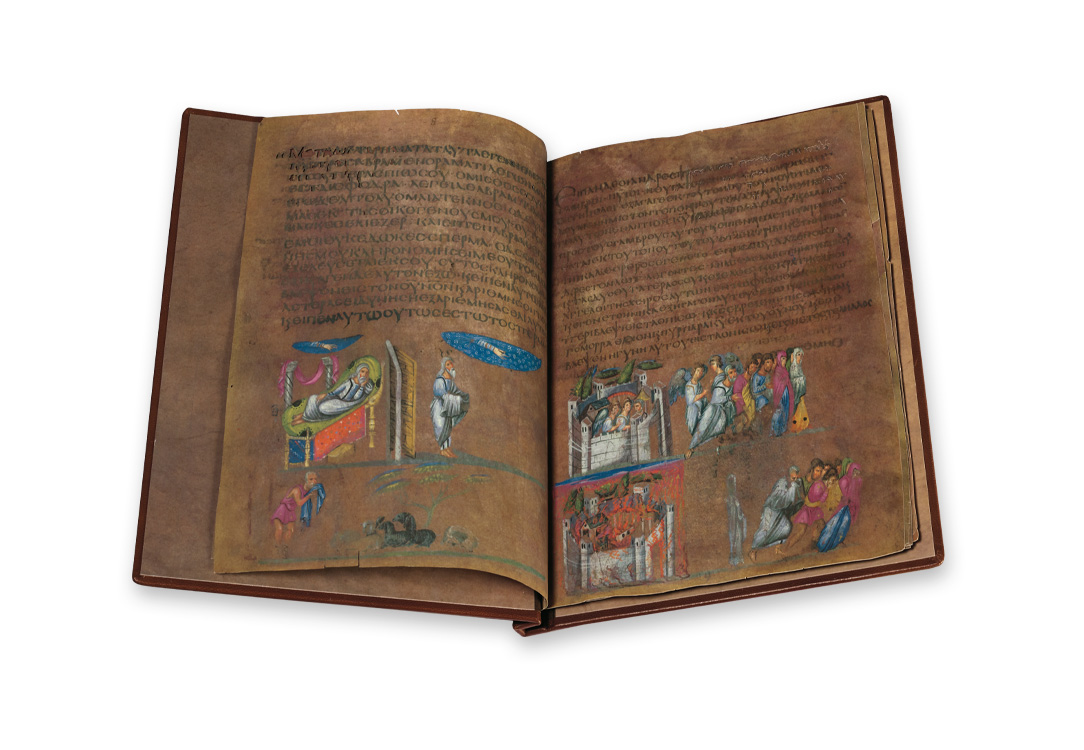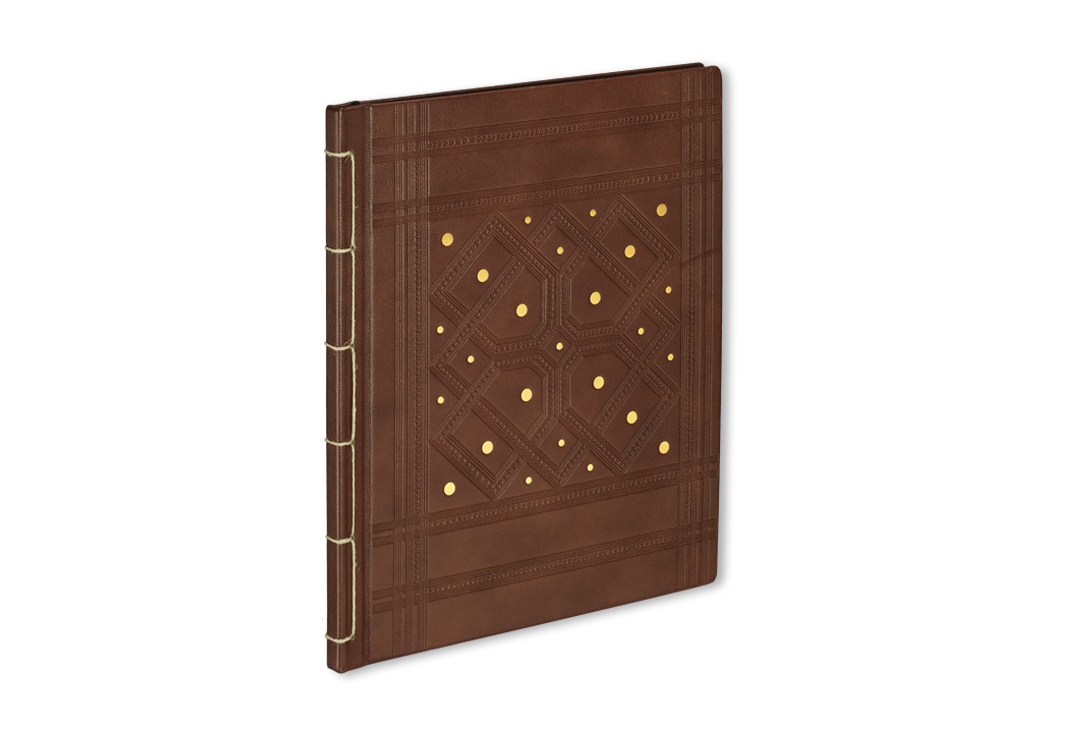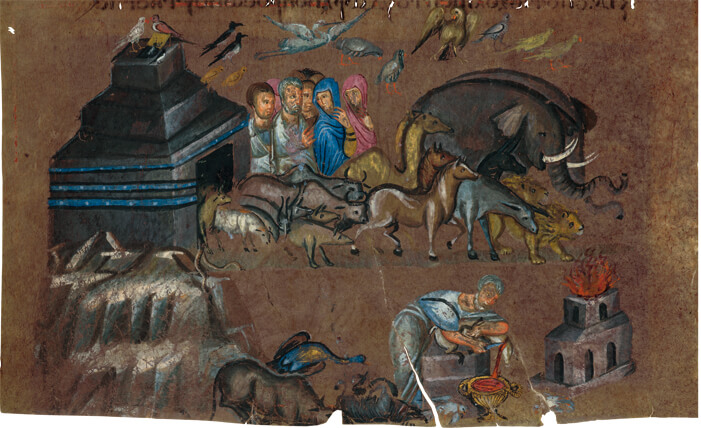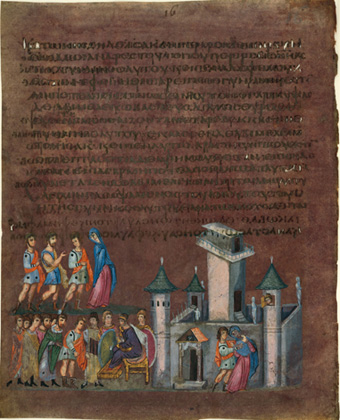The Vienna Genesis
The Power of Early Christian Imagery
Pages seeped in purple that has darkened to a brownish hue; colourfully narrated miniatures; silver ink for the text in uncial script; gold to adorn the details – the 6th-century Vienna Genesis is a cultural heritage of an unparalleled kind, and viewers still enthuse over its natural, life-like illumination, its intense colours, and the artistic mastery displayed in its rendering of facial expressions, gestures, movements, and perspective.
“The Vienna Genesis is an outstanding monument to the book art of late antiquity and the early Byzantine period, and it is of central importance to the collections of the Österreichische Nationalbibliothek. The fascination of this ‘picture Bible’ is undiminished even today.”
(Andreas Fingernagel, Österreichische Nationalbibliothek, Vienna)
Vienna Genesis:
The Vienna Genesis: The Manuscript
At the Beginning of Christian Manuscript Illumination
The 24 surviving folios of the Vienna Genesis, with their 48 miniatures in wonderfully fresh colours and their artistic pictorial inventions of a kind not found again in painting until centuries later, are a first-rank testimony to cultural history. They pass down the oldest surviving cycle of Biblical illuminations, and their origins point both temporally and geographically to the cradle of Christianity in the eastern Mediterranean and at the same time to the beginnings of the book in codex form. This splendid manuscript was created by manuscript illuminators in Antioch, one of the most important centres of early Christianity, in the province of Syria, where the arts were flourishing and luxury goods from all over the world were being traded.
Picture Stories with Text
In the Vienna Genesis, the images take precedence over the text. The images do not illustrate the text but instead, the adapted text explains the images. This preference for the images goes so far that the usual sequence of steps to produce an illuminated manuscript were reversed. It appears that the miniatures were created first before the scribes fitted the text into the blank spaces that remained. To that end, an editor with theological training abridged the Biblical text so that image and text would conform to each other as much as possible. Passages that would have been difficult to illustrate were omitted and only the events and actions crucial to the narrative flow were retained.
Imperial Luxurious Manuscript?
The Vienna Genesis – as its outstanding design, high-quality miniatures, and silver script make clear – is a luxurious manuscript of breath-taking splendour from late antiquity. Its depictions of kings feature the iconography of the Eastern Roman-Byzantine rulers (diadem, purple chlamys, and gold fibula). The Vienna Genesis was created during the reign of Emperor Justinian I (AD 482–565). It may have been produced for him or for a member of his family. One indication of this is the purple dyeing of the parchment. Purple was considered the colour of the emperor, and its use by private parties was prohibited. The abridged text of the codex rules out the possibility that it could have had a liturgical use.
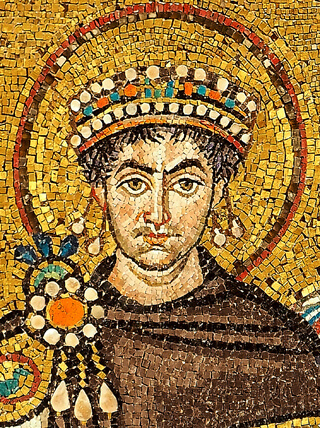
Vienna Genesis
Under the Magnifying Glass: Multi-scene Miniatures and Refined Compositions
The Vienna Genesis impresses the viewer particularly because of its uncommonly diverse compositions. For example, one passage of the text is often serialised in several scenes in one miniature, each scene connected to or separated from another by deliberately positioned elements of landscape and architecture. The “direction of reading” is variable: from top to bottom, from left to right, or vice versa. Such dynamics and the great artistic skill of the manuscript illuminators result in a visual experience that is always new. That can be seen, for example, in the extraordinarily lifelike way that the movement, postures, gestures, and facial expressions of the figures in the Vienna Genesis have been painted, as well in the varied design of the scenes with a dialogue.
The miniature on page 16 is a fine example of this. It depicts Isaac and Rebecca in Gerar, the city of the Philistine King Abimelech (Gen. 26.1–11). The left half of the image consists of two rows of figures, while the right half is completely filled with the king’s fortress. In the scene at the top left, Isaac is seen wearing a pale-green sleeved tunic and an orange cloak, answering negatively the question of the two Philistines as to Rebecca is his wife and instead identifying her as his sister. In the next scene on to the right, Isaac and Rebecca exchange endearments in front of the palace, while being observed by the king from a window in the tower. The latter, enthroned in full vestments, then asks Isaac to speak before the assembled court.
Vienna Genesis
The Vienna Genesis: The Edition


The Manuscript and the Facsimile at a Glance
The miniatures of the Vienna Genesis shine forth with astonishing colour from the early period of Christian illuminated manuscripts. The interplay of orange, green, blue, white, beige, purple, and pink in diverse shadings leaves an overall impression that is as pleasing as it is fresh, which the facsimile authentically reproduces.
Manuscript: Vienna, Österreichische Nationalbibliothek, Cod. theol. gr. 31
Date of Origin: first half of the sixth century
Place of Origin: Antioch (now Antakya) in the Roman province of Syria
Dimensions: c. 32.0 × 26.5 cm
Extent: 48 pages (24 leaves)
Artists: several manuscript illuminators (Masters of the Vienna Genesis)
Patron: unknown
Illumination: 24 folios in purple that has darkened to a brownish shade, with a total of 48 miniatures and 120 individual scenes, heightening in shell gold, with a text written in silver ink, letters and words of which have broken off over the course of centuries (the losses reproduced in the facsimile by means of laser punching)
Binding: dark-brown goatskin binding, richly ornamented with patterns in gold and blind-stamping
Commentary Volume for the Facsimile Edition by Barbara Zimmermann, Christian Gastgeber, and Christa Hofmann
Print run: 480 copies
This facsimile edition has been published under the great patronage of the Austrian UNESCO Commission.
Vienna Genesis
Enjoy Viewing a Few Sample Pages:
A Glance at the Facsimile Manuscript
The excerpt for perusal from the surviving fragments of the Vienna Genesis for perusal contains pp. 12–16, which begin by telling the story of Abraham’s servant Eliezer, who was sent by his master to find a wife for his son Isaac. In the end, he finds the beautiful Rebecca in Mesopotamia (Gen. 24). The miniature on the next page is devoted to the two sons birthed by Rebecca after she married her husband Isaac: Esau and Jacob. It depicts Esau returning home from the hunt, after selling his birthright for a pottage of lentils (Gen. 25.27–34). This is followed by the episode of Isaac and Rebecca in Gerar (Gen. 26.6–11).
Vienna Genesis
A Challenging Production: fac simile
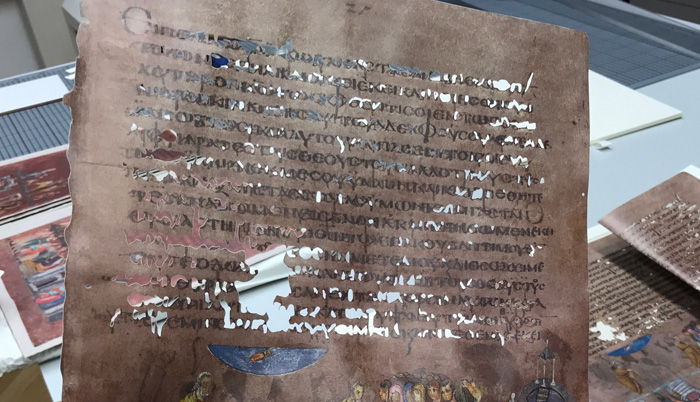
A Masterpiece of the Art of Punching
When Quaternio Editions Lucerne publishes a manuscript facsimile, fidelity to the original is the top priority. Accordingly, that is also true of the reproduction of the missing elements of the Vienna Genesis arising from the corrosion of the silver ink. Over a millennium and a half, it has eaten into the very thin, formerly purple parchment. Several letters and words in the lines of text have broken off. These missing elements were punched out of the printed pages of the facsimile with great precision by means of a laser. In this way, the facsimile offers an authentic experience of this fragile but splendid manuscript with all the traces of its ageing.
Gold and Silver Accents
In many miniatures of the Vienna Genesis, whose fresh-looking colours still stand out well on the parchment background, which has darkened to a brownish shade, the illuminators used the most delicate shell gold for details of garments, jewellery, rays of light, and furniture. To reproduce these areas, no matter how small, the lithographer produced his own areas of gold. Areas of silver are used for the few places where the original shimmer of the silver script has been preserved somewhat. When the light falls on the gold and silver as one browses through the facsimile edition, they are effectively brought to life, just as in the original.
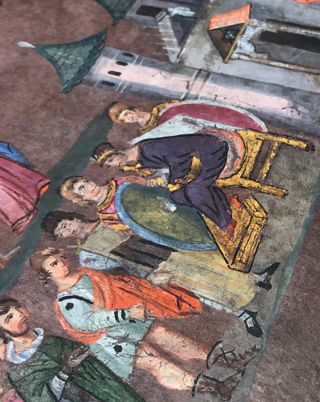
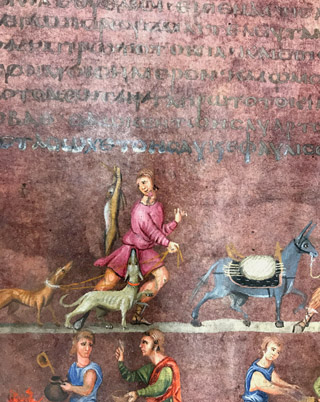
Vienna Genesis
The Facsimile Folder for the Edition
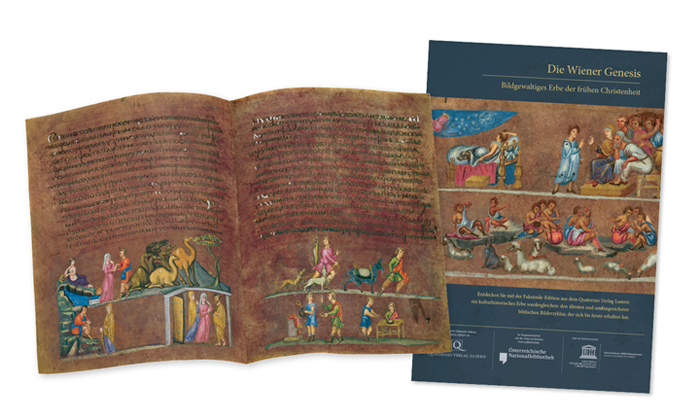
The facsimile folder for the edition of the Vienna Genesis allows the viewer to plunge into the fascinating visual world of early Christian manuscript illumination. The original double-page spread it contains from the facsimile (pp. 13–16) depicts the (hi)stories of Eliezer, Rebecca and Isaac, and Esau and Jacob in image and text. The multi-scene images have clearly been given precedence over the Greek Biblical text in uncials that once gleamed in silver. The brownish-tinted facsimile double-page spread is protected by a hand-bound cloth portfolio in madder red with gold embossing. The accompanying documentation offers 16 pages of introduction to the history and art of the Vienna Genesis, which dates from the first half of the 6th century, and its authentic facsimile.
Vienna Genesis
Order facsimile folder
Click here to go to the online shop (only available in German) where you can order the facsimile folder for the Vienna Genesis edition. Or send us an email to info@quaternio.ch.
Request brochure
We would be glad to provide you with additional information regarding the fine art facsimile edition of the Vienna Genesis. Click here to order the brochure.




